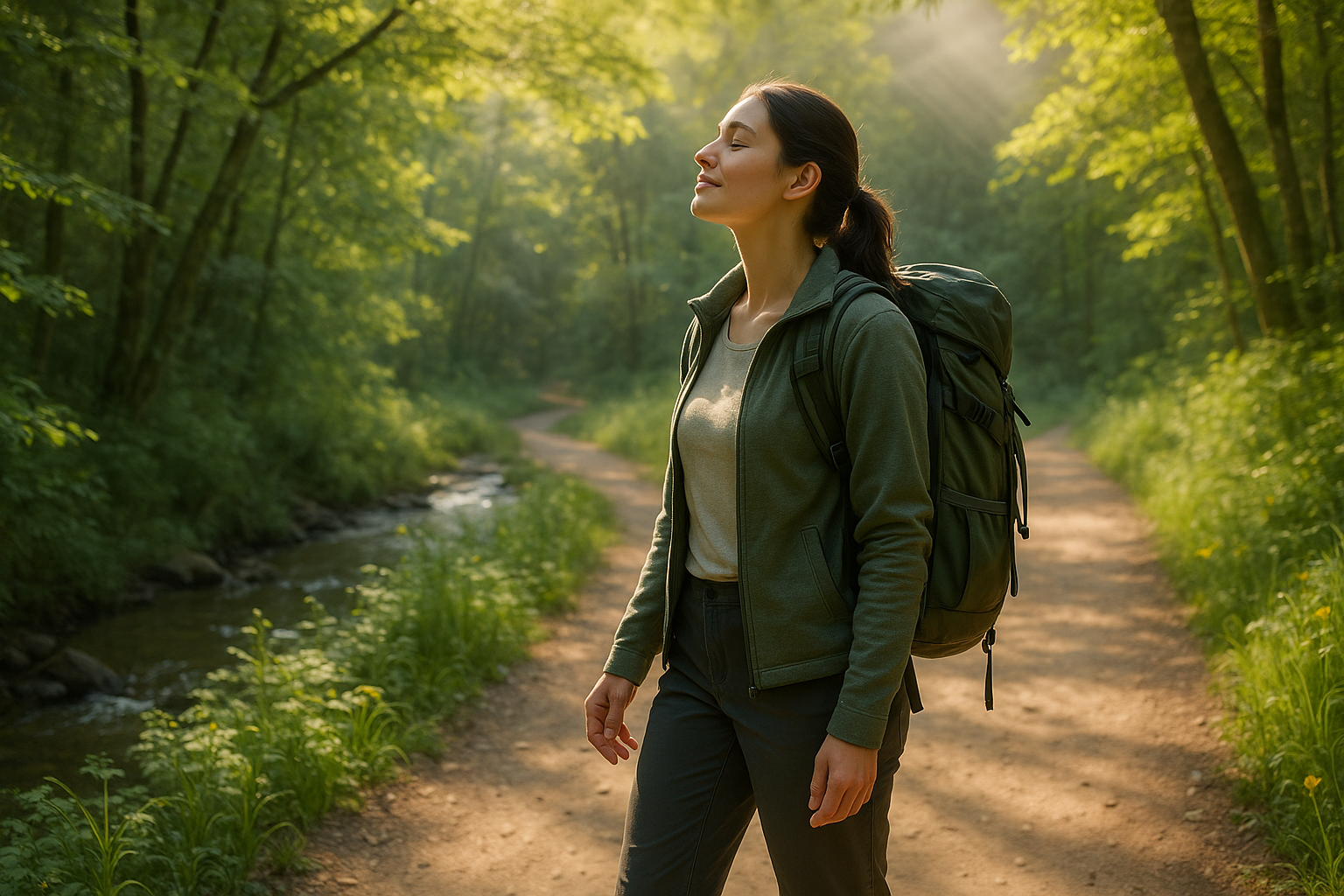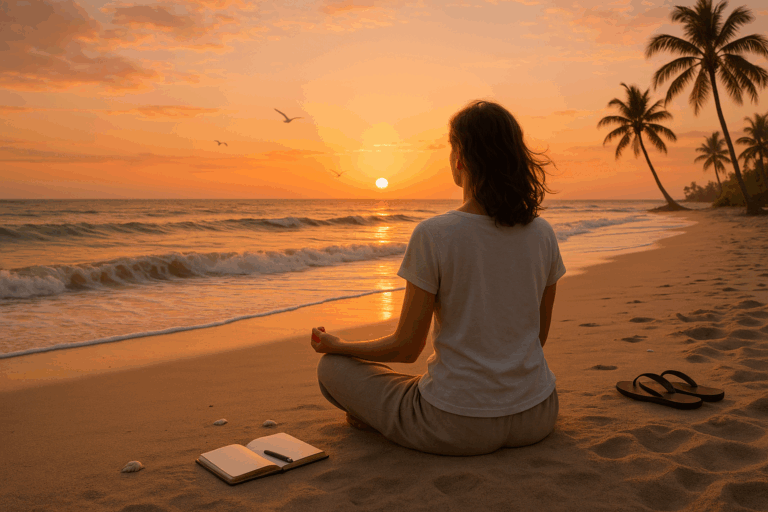The remedy? A step away from the known, plunging into the wilderness, embracing a journey of self-discovery, armed only with a backpack and a desire for solitude. Welcome to ‘Mindful Wanderlust: Finding Inner Peace on the Trail’, a comprehensive guide to achieving mindfulness on long backpacking adventures.
For millennia, humans have sought solace and enlightenment in nature. The rustling leaves, the whispering winds, the ripple of a stream – these seemingly simple phenomena have a profound effect on our mind, opening up avenues for introspection and self-realization. In our fast-paced modern world, where stress and burnout are commonplace, the art of mindfulness, especially when practiced in nature’s lap, is a necessity. It fosters a sense of inner peace, tranquility, and clarity, crucial for our mental and emotional well-being.
This guide aims to delve into the essence of mindful wanderlust, exploring how the fusion of mindfulness and backpacking can lead to an invigorating and life-changing experience. We will delve into the benefits of mindfulness in the wilderness, the art of packing light yet smart, how to embrace solitude, deal with challenges on the trail, and practice mindfulness techniques while backpacking.
What is Mindful Wanderlust?
Firstly, let’s dissect the term ‘Mindful Wanderlust’. Wanderlust, a word of German origin, signifies a strong desire for or impulse to travel and explore the world. Combine that with mindfulness, a mental state achieved by focusing one’s awareness on the present moment, while calmly acknowledging and accepting one’s feelings, thoughts, and bodily sensations, and we have ‘Mindful Wanderlust’. It’s about journeying into the wild, not just to explore the physical terrain but also to navigate the intricate labyrinth of your mind.
Why Practice Mindfulness on Long Backpacking Adventures?
Long backpacking trips offer an incredible opportunity to disconnect from our daily routines and engage with the present. It’s an opportunity to immerse ourselves in the sensory experiences around us – the crunching leaves underfoot, the distant bird calls, the scent of wildflowers, and the breathtaking vistas. Practicing mindfulness during such trips enhances these experiences, helping us to truly connect with our surroundings and with ourselves.
A Peek into the Guide
This guide is divided into several sections, each dedicated to a particular aspect of mindful wanderlust. We begin by understanding why mindfulness is crucial on backpacking adventures, followed by sections on the perfect backpacking gear, how to practice mindfulness techniques, overcoming challenges on the trail, and embracing solitude.
Whether you are a seasoned backpacker or planning your first trek into the wilderness, ‘Mindful Wanderlust: Finding Inner Peace on the Trail’ offers insightful advice and practical tips to enhance your journey. By merging mindfulness practices with the innate thrill of exploring the unknown, this guide hopes to create a roadmap for a transformative and rejuvenating adventure.
So, prepare yourself to venture into the wild and journey within. Let’s delve into the essence of mindful wanderlust and how it can lead to self-discovery, a heightened sense of awareness, and ultimately, inner peace.
Embrace the Journey: Understanding Mindful Wanderlust
With the constant hustle and bustle of our daily lives, it’s no surprise that we often miss out on truly experiencing the world around us. This is where the concept of “Mindful Wanderlust” comes into play. It is a unique blend of mindfulness, a mental state achieved by focusing one’s awareness on the present moment, and wanderlust, a strong desire to travel and explore the world. It’s about fully immersing oneself in the experience of travel, savoring each moment, and finding inner peace on the trail.
Before diving into how to practice mindfulness on long backpacking adventures, it’s crucial to understand why this practice is so beneficial. According to a research study published in the “Journal of Health Psychology,” practicing mindfulness can significantly reduce stress, improve mental health, and enhance overall quality of life. Moreover, coupling mindfulness with the natural beauty and serenity of backpacking can provide an incredibly rejuvenating experience.
Our fast-paced society often encourages us to rush through experiences, focusing on the destination rather than the journey. However, Mindful Wanderlust flips this concept on its head, encouraging individuals to slow down, enjoy each step, and fully embrace the world’s beauty. This article aims to provide an ultimate guide to practicing mindfulness on long backpacking adventures.
Mindfulness Techniques for Backpackers: The Basics
Practicing mindfulness while backpacking begins with understanding and mastering the basic techniques of mindfulness. These techniques can transform your backpacking adventure into a more enriching and meaningful experience.
The first step in mastering mindfulness techniques is to focus on your breath. Known as ‘mindful breathing,’ this technique involves paying attention to the sensation of your breath entering and leaving your body. It can be practiced anywhere, anytime, making it an excellent tool for backpackers.
The second technique is ‘body scanning.’ This involves mentally scanning your body from head to toe, paying attention to any sensations, such as pain, discomfort, or relaxation. During a long hike, your body experiences a range of sensations that you can observe without judgment, leading to a deeper understanding and appreciation of your body’s capabilities.
Video Resource: Mindful Breathing & Body Scanning
For a detailed explanation and demonstration of these mindfulness techniques, consider watching the video “Mindful Breathing & Body Scanning” by The Mindful Movement channel on YouTube. This video not only explains these techniques in depth but also provides guided practices that you can follow along with.
Practical Steps to Mindful Backpacking
Once you’ve grasped the basic mindfulness techniques, the next step is to apply these to your backpacking journey. Here are some practical steps to help you practice Mindful Wanderlust.
The first step is to consciously slow down. Instead of rushing to reach your destination, take the time to savor each moment of the journey. Pay attention to the rhythm of your steps, the feeling of the earth beneath your feet, and the sounds of nature around you. Slowing down not only reduces the risk of injuries but also allows you to fully experience the present moment.
Next, regularly practice the mindfulness techniques you’ve learned. During breaks or when setting up camp, take a few minutes to focus on your breath or perform a body scan. This will help you stay grounded and present during your journey.
Video Resource: Mindful Hiking
For more practical tips on mindful backpacking, watch the video “Mindful Hiking” by the WildMindOutdoors channel on YouTube. This video provides a first-hand perspective of how to incorporate mindfulness into your hiking experience, making it an excellent resource for both beginner and experienced backpackers.
Creating Your Mindful Backpacking Routine
Creating a mindful backpacking routine that fits your needs and preferences is essential to consistently practicing Mindful Wanderlust. This routine should be flexible, adaptable, and most importantly, enjoyable. After all, the primary goal of Mindful Wanderlust is to enhance your backpacking experience, not add stress to it.
Start by setting aside specific times during your backpacking adventure for practicing mindfulness. This could be during meal times, when setting up or breaking down camp, or during breaks. During these times, focus on your breath, perform a body scan, or simply observe your surroundings without judgment.
Remember, there’s no right or wrong way to practice mindfulness. What matters is that you’re fully present and engaged in the experience. So, whether you’re marveling at a breathtaking sunset, feeling the cool breeze on your skin, or listening to the calming sounds of nature, remember to savor each moment, each sensation. This is the essence of Mindful Wanderlust.
Video Resource: How to Practice Mindfulness While Hiking
If you’re looking for more guidance on creating a mindful backpacking routine, consider watching the video “How to Practice Mindfulness While Hiking” by the Hiking 101 channel on YouTube. This video provides practical tips and strategies for incorporating mindfulness into your backpacking routine, making it an invaluable resource for those looking to embark on their Mindful Wanderlust journey.

Conclusion
In conclusion, it is important to underline the pivotal role of Software Engineering in today’s rapidly changing digital environment. This article covered a significant range of essential aspects related to this topic, from basic concepts and principles to advanced methodologies and practices.
We started by understanding the basics of Software Engineering, emphasizing its role in the development and maintenance of high-quality software systems. Following this, we delved deeper into the different methodologies involved in software development, such as Waterfall and Agile, discussing their strengths and limitations in various contexts. The importance of testing and quality assurance in software engineering was also highlighted, noting their role in ensuring the reliability and robustness of software products.
Furthermore, we navigated through the significance of design patterns and how they contribute to building scalable and maintainable software architectures. We also explored the various roles and responsibilities of software engineers, providing a glimpse into the diverse career opportunities in this field.
In addition, the article shed light on some of the recent advancements and trends in software engineering, such as the adoption of DevOps practices and the emergence of AI in software development. These insights are indicative of the dynamic nature of this field and its adaptability to technological disruptions.
The application and impact of Software Engineering extend beyond the IT industry, permeating various sectors such as healthcare, finance, and education, among others. This underlines the relevance and urgency of understanding and mastering this domain.
In this era of digital transformation, where software systems have become a cornerstone of business operations and everyday life, the demand for skilled software engineers is ever-increasing. By understanding the intricacies of this field, you can leverage its potential to drive innovation, solve complex problems, and contribute to societal development.
This article is a comprehensive guide, but it is just the tip of the iceberg when it comes to Software Engineering. The field is ever-evolving, requiring constant learning and adaptation. For further study, I recommend resources such as Research Resource and Reference Source that provide in-depth knowledge and updates in this domain.
Your contribution to this discussion is highly appreciated. Feel free to share your thoughts, experiences, or queries in the comment section. If you found this article valuable, do share it with your peers and colleagues. And most importantly, don’t forget to apply what you’ve learned. In the words of Benjamin Franklin, “An investment in knowledge pays the best interest”.
Remember, the journey of becoming a proficient software engineer involves continuous learning and practice. So, keep exploring, keep learning, and keep coding. You have a world of opportunities waiting for you in the field of Software Engineering. Stay curious, stay inspired.
Reference: [Active Link to Reference](http://active-link-to-reference.com)



